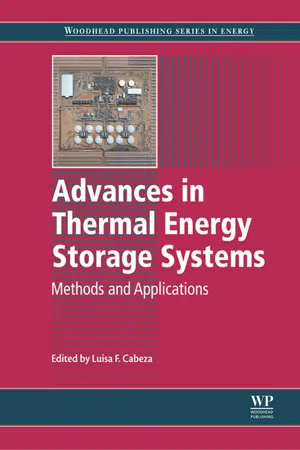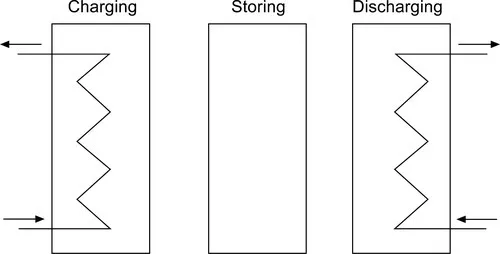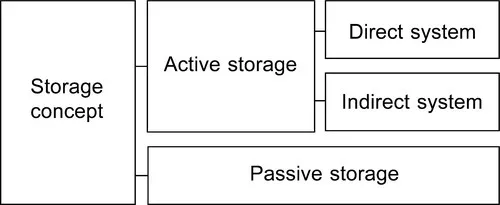
This is a test
- 612 pages
- English
- ePUB (mobile friendly)
- Available on iOS & Android
eBook - ePub
Book details
Book preview
Table of contents
Citations
About This Book
Thermal energy storage (TES) technologies store thermal energy (both heat and cold) for later use as required, rather than at the time of production. They are therefore important counterparts to various intermittent renewable energy generation methods and also provide a way of valorising waste process heat and reducing the energy demand of buildings. This book provides an authoritative overview of this key area. Part one reviews sensible heat storage technologies. Part two covers latent and thermochemical heat storage respectively. The final section addresses applications in heating and energy systems.
- Reviews sensible heat storage technologies, including the use of water, molten salts, concrete and boreholes
- Describes latent heat storage systems and thermochemical heat storage
- Includes information on the monitoring and control of thermal energy storage systems, and considers their applications in residential buildings, power plants and industry
Frequently asked questions
At the moment all of our mobile-responsive ePub books are available to download via the app. Most of our PDFs are also available to download and we're working on making the final remaining ones downloadable now. Learn more here.
Both plans give you full access to the library and all of Perlego’s features. The only differences are the price and subscription period: With the annual plan you’ll save around 30% compared to 12 months on the monthly plan.
We are an online textbook subscription service, where you can get access to an entire online library for less than the price of a single book per month. With over 1 million books across 1000+ topics, we’ve got you covered! Learn more here.
Look out for the read-aloud symbol on your next book to see if you can listen to it. The read-aloud tool reads text aloud for you, highlighting the text as it is being read. You can pause it, speed it up and slow it down. Learn more here.
Yes, you can access Advances in Thermal Energy Storage Systems by Luisa F. Cabeza in PDF and/or ePUB format, as well as other popular books in Technology & Engineering & Power Resources. We have over one million books available in our catalogue for you to explore.
Information
1
Introduction to thermal energy storage (TES) systems
L.F. Cabeza1; I. Martorell1; L. Miró1; A.I. Fernández2; C. Barreneche2 1 Universitat de Lleida, Spain
2 Universitat de Barcelona, Spain
2 Universitat de Barcelona, Spain
Abstract
Thermal energy storage (TES) systems can store heat or cold to be used later, under varying conditions such as temperature, place or power. TES systems are divided in three types: sensible heat, latent heat, and thermochemical. Clues for each TES system are presented in this chapter and requirements for each technology and application are given. An overview of system types and description of particular and novel applications are presented. The potential for energy saving and climate change mitigation using TES with a 10-year scenario is presented for specific cases. Finally, the CO2 mitigation potential of TES in different applications is presented.
Keywords
Thermal energy storage (TES)
sensible heat
latent heat
phase change material (PCM)
thermochemical energy storage
Requirements
Applications
Overview
Energy savings
CO2 mitigation potential
1.1 Introduction
Thermal energy storage (TES) systems can store heat or cold to be used later under varying conditions such as temperature, place or power. The main use of TES is to overcome the mismatch between energy generation and energy use [1–3]. In TES systems energy is supplied to a storage system to be used at a later time, involving three steps: charge, storage and discharge, giving a complete storage cycle (Figure 1.1).

Figure 1.1 TES complete storage cycle [3].
Storage concepts are active or passive systems (Figure 1.2) [4]. An active storage system is characterized by forced convection heat transfer into the storage material. The storage material circulates through a heat exchanger, a solar receiver or a steam generator. Active storage systems can be direct, the heat transfer fluid (HTF) serving also as storage medium, or indirect systems, where a second medium is used for storing the heat. Passive storage systems are generally dual-medium storage systems, where the HTF passes through the storage only for charging and discharging a solid material.

Figure 1.2 Scheme of classification of different storage systems according to the storage concept [3].
The main requirements for the design of a TES system are high energy density in the storage material (storage capacity), good heat transfer between the HTF and the storage material, mechanical and chemical stability of the storage material, compatibility between the storage material and the container material, complete reversibility of a number of cycles, low thermal losses during the storage period, and easy control. Moreover, the most important design criteria are the operation strategy, the maximum load needed, the nominal temperature and enthalpy drop, and the integration into the whole application system.
The benefits that can be obtained when implementing storage in an energy system are:
• better economics: reducing capital and operational costs
• better efficiency: achieving a more efficient use of energy
• less pollution of the environment and less CO2 emissions
• better system performance and reliability.
Arce et al. [5] calculated the potential of saved energy due to the use of thermal energy storage in Europe. The buildings and industrial sectors were evaluated, and grouped in cases where TES may be applied.
The cases considered for the buildings sector were seasonal solar thermal systems, district/central heating, short-term solar thermal systems, and passive cold systems. For the industrial sector the cases considered were combined heat and power (CHP, also called cogeneration), industry (heating and cooling systems), power stations and transport, and concentrated solar power plants.
In order to determine the TES potential, the required parameters are related to energy and CO2 emissions. Within the energy field, two quantities show the potential to be determined: the derived thermal load reduction and thermal/electrical energy savings.
The thermal load reduction refers to the reduction of ...
Table of contents
- Cover image
- Title page
- Table of Contents
- Copyright page
- List of contributors
- Woodhead Publishing Series in Energy
- Preface
- 1: Introduction to thermal energy storage (TES) systems
- Part One: Sensible heat storage systems
- Part Two: Latent heat storage systems
- Part Three: Thermochemical heat storage systems
- Part Four: Systems operation and applications
- Index